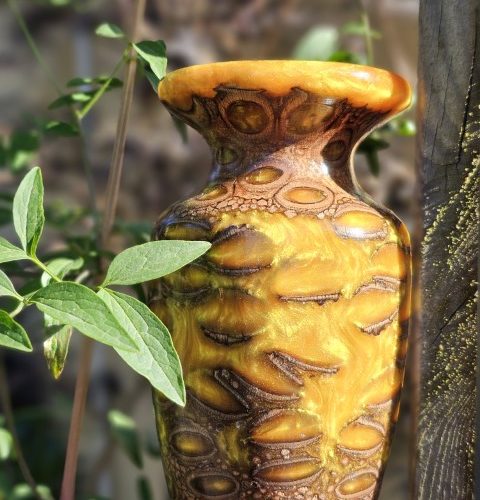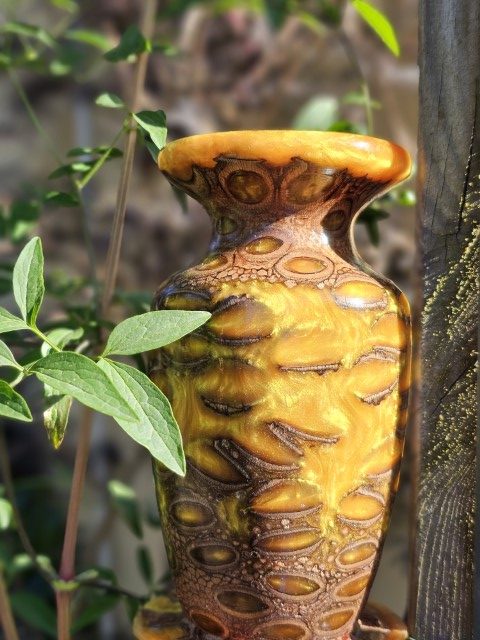A Guide to Wooden Vases: Form, Function & the Beauty of Nature
At Fairytale Wood, we believe in surrounding yourself with pieces that connect you to nature — not just in material, but in spirit. Wooden vases are a perfect example: they’re simple in purpose, endlessly varied in design, and rich in presence. From petite bud vases to sculptural decorative forms, each type brings something different to a room.
In this brief guide, we’ll explore the four main types of wooden vases we craft — twig pots, bud vases, flower vases, and decorative vases — and share how they differ in size, purpose, material needs, and design intent.
1. Twig Pots: Nature, Contained
Size: Very small (6–20cm tall)
Best for: Single twigs, dried grasses, or bare stems
Waterproof: Not needed (typically used dry)
Design vibe: Minimal, wabi-sabi (usually), textural
Twig pots are quiet, poetic objects. Typically turned small and narrow, they’re designed to hold just a single natural element — a bare branch, a sprig of lavender, or a found feather. Their role is less about flowers and more about celebrating negative space and texture.
We often use simple woods, often with imperfections, for twig pots to create smooth, tactile finishes. Because they don’t hold water, we’re free to explore fine, sculptural forms without liners. A twig pot on a shelf or windowsill adds a subtle, almost meditative presence — a visual pause. No epoxy, no added design, just the story of nature.
2. Bud Vases: Small Scale, Big Impact
Size: Small (10–20cm tall)
Best for: Single flowers or small clusters
Waterproof: Yes — usually lined with a glass or test tube insert
Design vibe: Light, elegant, versatile
Bud vases are compact and charming. Unlike twig pots, they’re made to hold fresh flowers, usually one or two stems. Because of this, waterproofing matters — we often incorporate removable inserts or narrow test tubes to hold water discreetly while keeping the wood protected.
Ash and elm work beautifully here, offering interesting grain while keeping the overall look fresh and modern. Bud vases shine in pairs or clusters on a dining table, bedside, or bathroom shelf — anywhere you want a pop of natural beauty without the scale of a full bouquet.
Bud vases can Double as twig pots for larger twigs too.
3. Flower Vases: Everyday Function Meets Natural Form
Size: Medium (16–30cm tall)
Best for: Floral arrangements (fresh or dried)
Waterproof: Yes — must be lined for fresh use
Design vibe: Balanced, functional, understatedly luxurious
Flower vases are the everyday workhorses — and the design challenge is balancing beauty and utility. These vases need to hold more stems, have good weight for stability, and include a protective liner (typically a fitted glass cylinder or resin coat) to handle water safely. There are more physical design contraints on flower vases than on other types. The neck must narrow to bunch together the blooms and widen to allow a spray. The height must allow for several inches of water and the width must fit the volume of flowers. Holes are of course not allowed in the main body. Classical forms are our favourite as they encompass all these requirements but we also play with modern forms such as a spiraling flower shape.
The materials vary enormously here whilst the size allows for patterning. From wood to epoxy, even to wood polymers anything is possible as long as it can be waterproofed.. One of our favourites are banksia pods with epoxy filling. We design them with clean curves, wide necks for breathability, and proportions that work across both contemporary and modern styles.
If you love having cut flowers at home, these belong on your kitchen island or dining table.
4. Decorative Vases: Sculpture First
Size: Varies widely (15–40cm+), form over function
Best for: Visual impact, often used empty or with dried elements
Waterproof: Usually not, could even be mostly a hole!
Design vibe: Artistic, sculptural, bold
Decorative vases are where we let form take the lead. These are not always made to hold anything — in fact, many are designed purely as sculptural objects, using exaggerated silhouettes, unusual grain, or carved features. They might nod to classical shapes or explore more abstract forms.
These vases take enormous work and are often the most expensive form.
Here, we have freedom in materials and in form, letting bold grain or spalting, or even holes become part of the design. Without the need for waterproofing, we can push the material’s limits and work with larger hollow forms or faceted shapes. Think of these as functional sculpture — objects that stand on their own or become part of a styled arrangement. 3d printed wood polymer is often integrated into the final piece.
Choosing the Right Vase: Aesthetic & Intent
Here are a few things to consider when choosing a wooden vase:
- Use: Fresh flowers need liners or epoxy sealing. Dried or decorative stems do not.
- Scale: Cluster smaller vases (twig or bud) in odd numbers; use medium or large vases as solo statements.
- Grain vs. Form: Bold grain (like oak or elm) suits simple silhouettes; subtle woods (like pear or walnut) invite more refined forms.
- Context: Bathrooms and bedside tables suit small vases. Dining and entry spaces benefit from taller, weighted pieces.
Care & Considerations
Wooden vases should never be directly filled with water unless specifically sealed inside (and even then, minimal contact is best). We provide inserts with our fresh-flower-ready designs or we seal with a tick coat of epoxy which is waterproof.. Clean gently with a dry cloth and avoid prolonged Strong sunlight or damp environments to protect the finish.
Living With Wooden Vases
Unlike glass or ceramic, wood adds warmth and presence to a space. Even when empty, a wooden vase brings life — the grain catching light, the form inviting touch. Whether you’re placing a single stem from your garden or simply styling a shelf, each piece is a conversation between the natural world and quiet design.
At Fairytale Wood, we hand-turn each vase to highlight the story of the materials it came from. No two are ever quite the same — because – neither are the moments they’ll hold, nor the stories they will tell.

